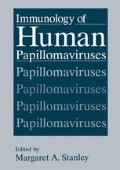Abstract
Normal human epithelial cells cultured from foreskin or cervical epithelia can be immortalized by a subset of HPV DNAs associated with a high risk of cervical cancer (Pirisi et al., 1987; Woodworth et al., 1989). The HPV-immortalized cell lines exhibit aberrant growth and differentiation when maintained as organotypic cultures (McCance et al., 1988) or in vivo (Woodworth et al., 1990). It is hypothesized that HPV oncoproteins E6 and E7 contribute to immortalization through their ability to bind the products of the tumor suppressor genes p53 and Rb, respectively (Munger et al., 1992).
Access this chapter
Tax calculation will be finalised at checkout
Purchases are for personal use only
Preview
Unable to display preview. Download preview PDF.
References
Asselineau, D., Bernard, B.A., Bailly, C., Darmon, M., and Pruniéras, M., 1986, Human epidermis reconstructed by culture—is it normal?, J. Invest. Dermatol. 86:181.
Eliyahu, D., Michalovitz, D., Eliyahu S., Pinhasi-Kimhi, O., and Oren, M., 1989, Wild type p53 can inhibit oncogene-mediated focus formation, Proc. Natl. Acad. Sci. (USA) 86:8763.
Hubbert, N.L., Sedman, S.A., and Schiller, J.T., 1992, Human papillomavirus type 16 E6 increases the degradation rate of p53 in human keratinocytes, J. Virol. 66:6237.
Levine, A.J., Momand, J., and Finlay, C.A., 1991, The p53 tumor suppressor gene, Nature(Lond.) 352:453.
McCance, D.J., Kopan, R., Fuchs, E., and Laimins, L.A., 1988, Human papillomavirus type 16 alters human epithelial cell differentiation in vitro, Proc. Natl. Acad. Sci. (USA)} 85:7169.
Munger, K., Scheffner, M., Huibregtse, J.M., Howley, P.M., 1992, Interactions of HPV E6 and E7 oncoproteins with tumor suppressor gene products, Cancer Surv. 12:197.
Pirisi, L., Yasumoto, S., Feller, M., Doniger, J., and DiPaolo, J.A., 1987, Transformation of human fibroblasts and keratinocytes with human papillomavirus type 16 DNA, J. Virol. 61:1061.
Scheffner, M., Munger, K., Byrne, J.C., and Howley, P.M., 1991, The state of the p53 and retinoblastoma genes in human cervical carcinoma cell lines, Proc. Natl. Acad. Sci. (USA) 88:5523.
Scheffner, M., Werness, B.A., Huibregtse, J.M., Levine, A.J., and Howley, P.M., 1990, The E6 oncoprotein encoded by human papillomavirus types 16 and 18 promotes the degradation of p53, Cell 63:1129.
Vogelstein, B. and Kinzler, K.S., 1992, p53 function and dysfunction, Cell 70:523.
Vousden, K.H., 1990, Human papillomavirus oncoproteins, Semin. Cancer Biol 1:415.
Woodworth, C.D., Doniger, J., and DiPaolo, J.A., 1989, Immortalization of human foreskin keratinocytes by various human papillomavirus DNAs corresponds to their association with cervical cancer, JVirol. 63:159.
Woodworth, C.D., Waggoner, S., Barnes, W., Stoler, W.H., and DiPaolo, J.A., 1990, Human cervical and foreskin epithelial cells immortalized by human papillomavirus DNAs exhibit dysplastic differentiation in vivo, Cancer Res. 50:3709.
Woodworth C.D., Wang, H., Simpson, S., Alvarez-Salas, L.M., and Notario, V. 1993, Overexpression of wild-type p53 alters growth and differentiation of normal human keratinocytes but not human papillomavirus-expressing cell lines, Cell Growth Diff. 4:367.
Author information
Authors and Affiliations
Editor information
Editors and Affiliations
Rights and permissions
Copyright information
© 1994 Springer Science+Business Media New York
About this chapter
Cite this chapter
Woodworth, C.D., Wang, H., Alvarez-Salas, L.M., DiPaolo, J.A. (1994). Enhanced Production of Wild-Type P53 Inhibits Growth and Differentiation of Normal Foreskin Epithelial Cells but not Cell Lines Containing Human Papillomavirus DNA. In: Stanley, M.A. (eds) Immunology of Human Papillomaviruses. Springer, Boston, MA. https://doi.org/10.1007/978-1-4615-2449-6_2
Download citation
DOI: https://doi.org/10.1007/978-1-4615-2449-6_2
Publisher Name: Springer, Boston, MA
Print ISBN: 978-1-4613-6041-4
Online ISBN: 978-1-4615-2449-6
eBook Packages: Springer Book Archive

